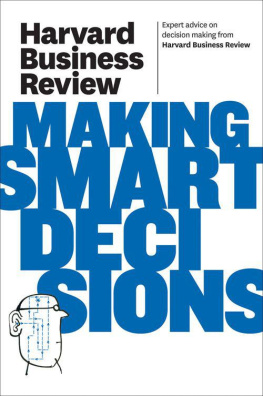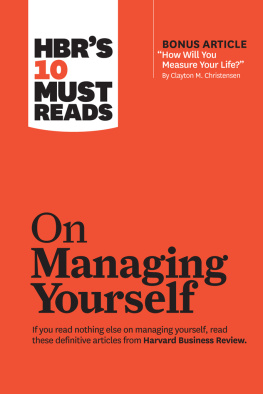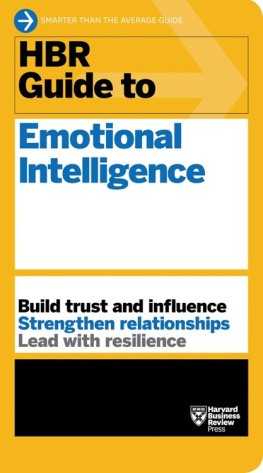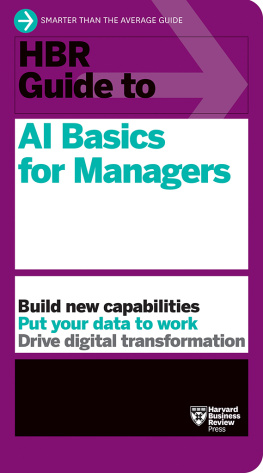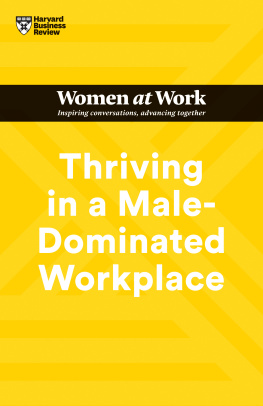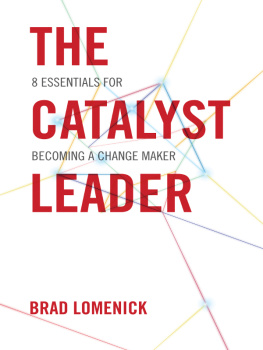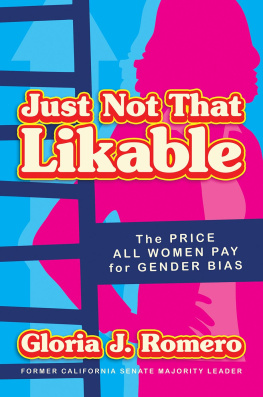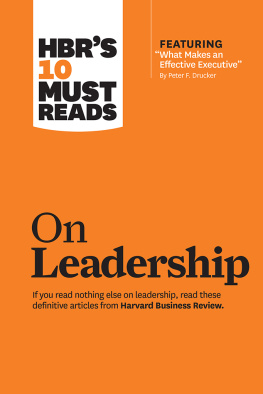Contents
Guide
NOTES
Chapter 2
. Madeline E Heilman and Tyler G Okimoto, Why Are Women Penalized for Success at Male Tasks?: The Implied Communality Deficit, Journal of Applied Psychology 92, no. 1 (2007): 8192; Amy J. C. Cuddy, Susan T. Fiske, and Peter Glick, When Professionals Become Mothers, Warmth Doesnt Cut the Ice, Journal of Social Issues 60 (2004): 701718.
. Wei Zheng, Olca Surgevil, and Ronit Kark, Dancing on the Razors Edge: How Top-Level Women Leaders Manage the Paradoxical Tensions Between Agency and Communion, Sex Roles 79 (2018): 633650.
Chapter 3
.
. Lakshmi Ramarajan and Erin Reid, Shattering the Myth of Separate Worlds: Negotiating Nonwork Identities at Work, Academy of Management Review 38 (2013): 621644.
.
Lakshmi Ramarajan, Nancy P. Rothbard, and Steffanie L. Wilk, Discordant vs. Harmonious Selves: The Effects of Identity Conflict and Enhancement on Sales Performance in EmployeeCustomer Interactions, Academy of Management Review 60 (2017): 22082238; Niklas K. Steffens et al., How Multiple Social Identities Are Related to Creativity, Personality and Social Psychology Bulletin 42, no. 2 (2016): 188203.
.
. Andrew Molinsky, Cross-Cultural Code-Switching: The Psychological Challenges of Adapting Behavior in Foreign Cultural Interactions, Academy of Management 32, no. 2 (April 2007).
Chapter 4
. Bernard M. Bass and Francis J. Yammarino, Congruence of Self and Others Leadership Ratings of Naval Officers for Understanding Successful Performance, Applied Psychology 40, no. 4 (1991): 437454; Paul J. Silvia and Maureen E. OBrien, Self-Awareness and Constructive Functioning: Revisiting the Human Dilemma, Journal of Social and Clinical Psychology 23, no. 4 (2004): 475489; Kenneth N. Wexley et al., Attitudinal Congruence and Similarity as Related to Interpersonal Evaluations in ManagerSubordinate Dyads, Academy of Management Journal 23, no. 2 (1980): 320330.
. Ellen Van Velsor, Sylvester Taylor, and Jean B. Leslie, An Examination of the Relationships Among Self-Perception Accuracy, Self-Awareness, Gender, and Leader Effectiveness, Human Resource Management 32, no. 23 (1993): 249263; Scott Taylor and Jacqueline Hood, It May Not Be What You Think: Gender Differences in Predicting Emotional and Social Competence, Human Relations 64, no. 5 (2011): 627652.
Pedja Stevanovic and Patricia Rupert, Career-Sustaining Behaviors, Satisfactions, and Stresses of Professional Psychologists, Psychotherapy: Theory, Research, Practice, Training 41, no. 3 (2004): 301309.
. Judith L. Meece et al., Sex Differences in Math Achievement: Toward a Model of Academic Choice, Psychological Bulletin 91, no. 2 (1982): 324348; Kristen C. Kling et al., Gender Differences in Self-Esteem: A Meta-Analysis, Psychological Bulletin 125, no. 4 (1999): 470500.
. Arthur I. Wohlers and Manuel London, Ratings of Managerial Characteristics: Evaluation Difficulty, Co-worker Agreement, and Self-Awareness, Personnel Psychology 42, no. 2 (1989): 235261; Rachel E. Sturm et al., Leader Self-Awareness: An Examination and Implications of Womens Under-Prediction, Journal of Organizational Behavior 35, no. 5 (2014): 657677.
. Taylor and Hood. It May Not Be What You Think.
.
. Lareina Yee et al., Women in the Workplace 2016 (McKinsey & Company and Lean In, 2016).
.
.
. Sturm et al., Leader Self-Awareness.
Tomi-Ann Roberts, Gender and the Influences of Evaluation on Self-Assessment in Achievement Settings, Psychological Bulletin 109, no. 2 (1991): 297308.
. Simine Vazire and Erika Carlson, Others Sometimes Know Us Better Than We Know Ourselves, Current Directions in Psychological Science 20, no. 2 (2011): 104108; Bass and Yammarino, Congruence of Self..
Chapter 13
.
.
.
.
.
.
.
.
Chapter 14
.
.
Chapter 16
. Kirsten Weir, Feel Like a Fraud? gradPSYCH 11, no. 4 (2013): 24.
. Pauline Rose Clance and Suzanne Imes, The Impostor Phenomenon in High Achieving Women: Dynamics and Therapeutic Intervention, Psychotherapy Theory, Research and Practice 15, no. 3 (1978): 241247.
.
.
Chapter 17
.
. Alice Eagly and Linda L. Carli, Women and the Labyrinth of Leadership, Harvard Business Review , September 2007.
. Herminia Ibarra and Otilia Obodaru, Women and the Vision Thing, Harvard Business Review , January 2009.
Chapter 18
.
.
.
.
. Herminia Ibarra, Nancy M. Carter, and Christine Silva, Why Men Still Get More Promotions Than Women, Harvard Business Review , September 2010.
Chapter 19
. David R. Hekman, Stefanie K. Johnson, Maw-Der Foo and Wei Yang, Does Diversity-Valuing Behavior Result in Diminished Performance Ratings for Non-White and Female Leaders? Academy of Management Journal 60, no. 2 (2016).
. Belle Derks, Colette Van Laar, and Naomi Ellemers, The Queen Bee Phenomenon: Why Women Leaders Distance Themselves from Junior Women, The Leadership Quarterly 27, no. 3 (2016): 456469.
.
.
. Ibid.
.
. Krivkovich et al., Women in the Workplace 2017.
Discussion Guide
Since the Women at Work podcast first launched, weve heard from all over the world that it has inspired discussions and listening groups. We hope that this book does the samethat youll want to share what youve learned with others. The questions in this discussion guide will help you talk about the challenges women face in the workplace and how we can work together to overcome them.
You dont need to have read the book from start to finish to participate. To get the most out of your discussion, think about the size of your group. A big group has the advantage of spreading ideas more widelywhether throughout your organization or among your friends and peersbut might lose some of the honesty and connection a small group would have. You may want to assign someone to lead the discussion to ensure that all participants are included, especially if some attendees are joining virtually. And its a good idea to establish ground rules around privacy and confidentiality. Women at Work topics touch on difficult issues surrounding sexism and racism, so consider using trigger warnings.
Finally, think about what you want to accomplish in your discussion. Do you want to create a network of mutual support? Hope to disrupt the status quo? Or are you simply looking for an empathetic ear? With your goals in mind, use the questions that follow to advance the conversation about women at work.
- What leadership traits are valued in your organization? Do you feel these are a fair representation of what both men and women can bring to the table? What are some of the double binds youve faced as youve pursued promotions and leadership positions?
- In , Nicole asks Tina Opie what the difference is between being inauthentic and being pushed out of your comfort zone. As you think about becoming a leader, how would you answer this question?
- Think back to an instance where you were angry or frustrated at work. How did you respond? Did your reaction help or hurt the situation, and what would you do differently next time? How are strong emotions generally handled in your workplace?
- In , Muriel Maignan Wilkins and Amy Jen Su describe the first time they were seen as leaders. Have you had a moment when you were first seen as a leaderformally or informally? Who saw you as that leader, and what did they say or do that conveyed that feeling to you?
- What are the largest struggles youve faced as you work to embody leadership presence and develop your leadership voice? How have others responded to you?
- What are the qualities you want in a sponsor? If you have a sponsor, how did you ask the person to take on that role, and what are some ways that you work together productively? If you dont have a sponsor, what are some of the barriers youre facing in securing this relationship?


